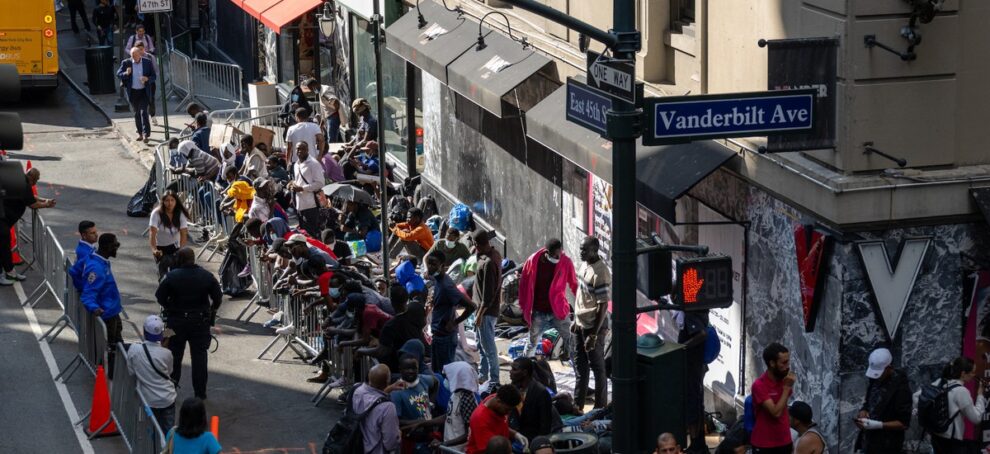After 42 years, New York City’s “right to shelter,” which was supposed to guarantee a bed to anyone who sought one the same day, has functionally ended.
Mayor Eric Adams has warned for months this moment was approaching, and even went to court this past spring to try to have the city released from the consent decree it entered into decades ago.
But the end of the right to shelter for adult migrants didn’t come by way of a press release or a court order. Instead, it happened quietly.
For months, as the number of migrants arriving in New York climbed, city workers raced to open more and more shelters in increasingly ad hoc settings to accommodate them. Now that era has come to an end, with the Adams administration letting the chips, and the people, fall where they may.
That new reality is on stark display outside an East Village “reticketing center,” where every morning for the past few weeks, hundreds of people — mostly men — have queued in the frigid pre-dawn hours in a line that snakes around the block.
The building, the former St. Brigid’s Catholic School on East 7th Street, is now the centralized intake point for adult migrants who’ve run out their time in shelters — since the city has begun to put that on a clock — and are seeking a bed for another 30 days.
Those seeking a place to sleep are given a wristband with a number and a date scribbled in sharpie, indicating how many people are before them in line. The number of those waiting for cots, spread out across a network of emergency shelters across the city, is likely in the thousands, and it now takes more than a week to secure one.
Dozens of migrants told THE CITY over the past two weeks that they have been waiting more than seven days to get a shelter cot, with many spending their nights on the streets, in trains or they’re directed to an increasingly overcrowded waiting room in The Bronx near Crotona Park overseen by the city’s Office of Emergency Management.

As the number of those waiting for beds grew this week, and temperatures slumped below freezing, the city opened additional satellite waiting rooms, where migrants are not always allowed to lie down on the floor, have limited access to food, and nowhere to bathe.
“Why is the government letting us sleep in the streets? With this cold, it’s really ugly,” said 19-year-old Bryan Arriaga, from Mexico, who described being turned away from a mobbed shelter intake office on Dec. 7.

He then spent a night on the floor of a city waiting room in The Bronx and another few nights sleeping in a public restroom in Jamaica, Queens.
On Dec. 12, he returned to the East Village, along with hundreds of others in much the same situation. Perched on a park bench across from the throngs of people surrounding the intake site, he debated his next move.
“I want a place to sleep, a place to bathe, a place to lie down, sleep like eight hours,” he said. “I’m really stressed, I’m sad.”
The collapse of the city’s right to shelter protections currently impacts adult migrants, who are now allotted just 30-days in a shelter before they have to seek a new placement and brave the line of hundreds at the intake center. While Adams has said repeatedly that the goal is never to have families with children sleeping on the streets, new restrictions are coming for thousands of migrant families with children too who account for a vast majority of migrants in shelters.
Thousands of 60-day eviction notices were scheduled to begin expiring in the weeks after Christmas, part of the city’s multipronged efforts to deter more migrants from coming to New York and to encourage those in shelters here to leave.
City Hall didn’t return a request for comment on the functional end to the city’s right to shelter and the situation for thousands of migrants awaiting shelter.
‘You’re Killing Us’
At the East Village reticketing site, meals of sandwiches and fruit are provided for those who make it inside. While a lucky few get assigned a new cot each day, hundreds more are shooed away each night when the facility closes at 7 p.m., directed to a series of waiting rooms across the city with chairs, but no cots.
The main overnight waiting room where migrants have been sent each night The Bronx, an hour and a half commute away from the East Village site. Migrants told THE CITY it’s increasingly cramped, smelly and dirty, with no shower on site. The only things available to eat there are crackers and tuna.
Some have abandoned the nightly schlep to The Bronx altogether. Nearly every night for the past two weeks, a group of migrants have set up camp outside the East Village site, a group that dwindles to under a dozen when temperatures dip particularly low, and has grown to as many as four dozen on warmer nights.
One evening last week, a group of them fortified shelters made of cardboard boxes, salvaged plastic tarps, and wooden slats from discarded bed-frames while trading tips on how to brave the cold. Some said they had too much luggage to carry halfway across the city, others said they preferred the sidewalk to the overcrowded waiting rooms.
“I’m wearing two pairs of gloves, three pairs of pants and four jackets,” said Yaleiza Goyo, 55, from Venezuela, who said she’d spent four of the past five sleeping on the sidewalk outside the reticketing center. “I have to fight it out, because what else am I going to do?”

On Sunday night it rained, and city workers sent those sleeping outside to a NYPD gym in Gramercy Park but there, Goyo said, they were barred from laying on the floor and had to spend the rest of the night sitting up in folding chairs.
“You’re killing us. How can you sleep sitting up? But it was raining. We had to stay,” she said. As she put the finishing touches on the cardboard hut where she would spend another night, she chuckled. “You have to laugh at life, so as not to cry.”
Goyo was one of an increasing number of women camping outdoors. Another Venezuelan migrant, 38-year-old Nailett Aponte, said she’d spent the past week waiting for a cot, sleeping outdoors on most nights.
“They don’t have beds for couples. They don’t have beds for single women. There’s nothing,” she said in Spanish.
Aponte later told THE CITY, she finally got a cot assignment on Wednesday, seven days since she began her wait for one.
Migrants who spoke with THE CITY said they’d lost jobs in restaurants and construction while waiting. They’d skipped appointments, scheduled weeks in advance, to get their NYC ID cards, a vital piece of identification, and feared they would end up without the paperwork — mailed by the federal government to their former shelters — that would allow them to work legally.
The days they’d spent trying to secure another cot, had likely set them back weeks in their effort towards being able to support themselves and move out of shelters for good.
“I should be working, not smoking cigarettes and drinking coffee outside here,” said Krist Benitez, in Spanish, who said he’d lost work as a dishwasher in the days he’d been sleeping outside waiting for a shelter cot. Clasping a folder of paperwork, he said both his city ID and his Occupational Safety and Health Administration certification, needed to work most construction gigs, were set to be shipped to his old shelter, and he had no idea if he’d be able to get his hands on them.
“I don’t understand it,” he said.
Still countless others have already given up on the waiting. The lucky ones found a room to rent, or a couch to crash on. Others have accepted free tickets out of the city and are trying out life in other cities and states. Countless more have slipped into precarious living situations on the streets and subways. While city officials say only 20 percent of people evicted from shelters are returning for another placement, they have no data on where all the other people go.
One Venezuelan migrant, David, who declined to share his full name, said after his 30 days in shelters ran out, he’d given up on seeking another placement, having heard through the grapevine about the chaotic reticketing center.
In the days since, he’s been sleeping in a friend’s van.
“It’s difficult,” he told THE CITY in Spanish. “I’ll stay here until I can find a room.”
‘New Yorkers Are Pissed’
The chaos over the past two weeks is the culmination of more than a year over which more than 140,000 migrants have made their way to New York City, many drawn by the city’s right to shelter, that up until recently had meant they could count on some roof over their heads while they got on their feet.
For months, Mayor Adams has argued the city’s “right to shelter” is an antiquated rule that was more than New Yorkers could afford to maintain on behalf of an unprecedented number of new arrivals.
When the 1981 legal consent decree establishing it was hammered out, it applied only to adult men and the city had to provide just 125 beds for homeless New Yorkers. Now there are more than 122,100 people living in shelters, including 65,000 migrants, a larger population than Hartford, Connecticut.
At a press conference in October, Adams put it bluntly:
“There’s two schools of thought in the city right now. One school of thought states you can come from anywhere on the globe and come to New York and we are responsible, on taxpayers limited resources, to take care of you for as long as you want: Food, shelter, clothing, washing your sheets, everything, medical care, psychological care for as long as you want. And it’s on New York City taxpayer’s dime,” he said. “And there’s another school of thought: that we disagree.”

Other mayors, including Rudy Giulani and Michael Bloomberg, have tried to walk back the requirements of the 1981 Callahan decree, none successfully. In 2009, When shelter waiting rooms overflowed with men and women sleeping on the floors in 2009, the Legal Aid Society and the Coalition for the Homeless took the city to court, and a judge forced the city to open up hundreds more beds to homeless New Yorkers.
Over the past year, as tens of thousands of migrants made their way to New York, the rules laid out in the decree have been breached countless times. Longstanding protections under the decree — requiring beds to be spaced three feet apart, for example — were abandoned months ago. Over the summer the protections briefly collapsed altogether, with hundreds of migrants sleeping on the sidewalk for a week straight during a heat wave.
And for months Adams has been teasing an unspecified next phase where the city would identify large outdoor spaces, where migrants would get individual tents, and some kind of access to bathrooms and showers, in the absence of meaningful federal funds to federal immigration policy.
That next phase is here, albeit not in the form hinted at by the mayor. It started when the Adams administration quietly opened the East Village “reticketing sight” in October, and for the first time the city began explicitly telling migrants they were not guaranteed a cot, though they could get a plane ticket to any state or country. For several weeks, the number of cots freed up across shelters was enough to accommodate those seeking another 30-day stay within a reasonable amount of time.
But that tedious equilibrium collapsed over the Thanksgiving holiday, when the city saw another unexpected wave of migrant adults coming from the southern border. The city has been short hundreds of cots for adults every day since.
It’s a moment Diane Enobabor, founder of the Black and Arab Migrant Solidarity Alliance, calls “organized abandonment.” Some will wait it out, some will leave, untold others will fall through the cracks.
“Some will die. I don’t think we should be shy about that,” Enobabor said. “Some will die.”
Attorney Joshua Goldfein with the Legal Aid Society, which represents Coalition for the Homeless, said while it may be currently impossible to secure a cot in a timely manner, it doesn’t mean New Yorkers right to one is gone. Goldfein said he is in regular touch with city officials, pressuring them to uphold the rules.
“There is a court order and it is on the books and it remains in effect,” he said. “I don’t think anyone would deny that they are not in compliance. So the question is what is gonna be the remedy for that?”
‘I Don’t Have Deportation Powers’
While Adams has faced increasingly loud criticism from the progressive left, polls indicate he’s not out of step with most New Yorkers, who are increasingly souring on the situation. The mayor has blamed the cost of migrant care for a surprise round of big mid-year budget cuts that would affect services including police, fire, sanitation, schools and libraries.
For the billions the city has spent on the crisis, the federal government has offered to reimburse just $159 million, though federal immigration policies that allow people to cross the border to seek asylum also prevent them from working legally for months.
While Adams has a record low approval rating, according to a Quinnipiac poll from early earlier this month, 62% of New Yorkers agreed with his assessment that migrants could destroy New York City — even as 66% of the respondents said they disapproved of how the mayor was handling the new arrivals.
Responding to the poll numbers at a press briefing Tuesday, Adams said people he talks to “are pissed off” and that he shared their anger:
“Why are you allowing the buses in, Eric? Why aren’t you stopping them from coming in?,” he said people ask him. His response: “I don’t have deportation powers. I don’t have the power to turn buses around. … And all I have the power to do is to balance the budget.”
‘No One Told Me the Truth’
Jesus Lopez, an 18-year-old from Venezuela, said he’d crossed the border alone around a month ago, and first got a free bus from Texas to Chicago, where he spent three weeks sleeping on the floor of a police precinct. From there he heard from other migrants things would be easier for him in New York, but when he arrived by bus he was lost, and wandered around the streets for about a week without a jacket, sleeping on the subways and any warm spot he could find.
Eventually, someone on a train told him about the main migrant intake center at Roosevelt Hotel in Midtown.

While city officials have said adults just arriving in New York get top priority for placements there, ahead of those who’ve already had their 30-days in shelters, Lopez said he was turned away and directed to the reticketing site, where he joined thousands of others seeking a 30-day stint. For the better part of the past week, Lopez said, he spent days in and out of the East Village waiting room, and nights in the waiting room in The Bronx, hardly sleeping or eating, and not showering at all.
His teeth rattled in the subzero temperatures Tuesday night, as he got some air outside the overcrowded overnight waiting room in The Bronx. Lopez said his time in New York had, thus far, been better than his experience in Chicago, but the ordeal was jarring just the same.
“No one told me the truth. I’m shocked,” he said in Spanish, adding he’d been given the number 3,752 in line for a cot. “I don’t know what to think. I’m speechless.”
Source : The City












Add Comment